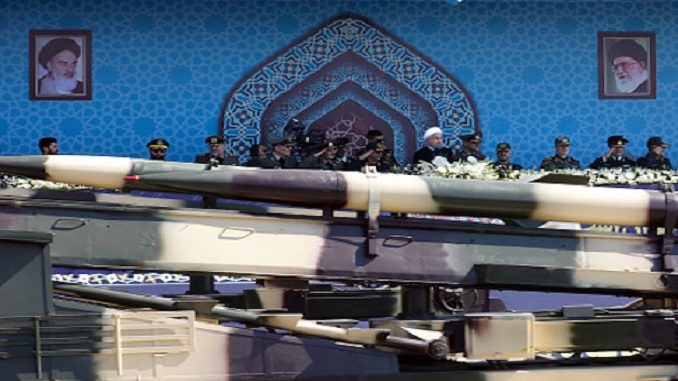
Iran has unveiled a series of new homemade ballistic missiles capable of causing nuclear devastation – with experts suggesting the regime is copying North Korea’s World War 3 technology, Express reports. Iranian President Hassan Rouhani delivered a speech during a ceremony to mark the 39th anniversary of the Islamic revolution, introducing the missiles at a military parade.
In a move which experts view as posturing amid dissidents’ efforts to stir protest, Iranian leaders flaunted the ballistic missile capabilities which include a nuclear-capable medium-range missile. According to experts, the missile appears to share similarities with North Korean technology.
The showcase comes after a heated encounter when Israeli forces shot down an Iranian drone which was launched from Syria. Israeli forces struck many Iranian targets in the region. The nuclear-capable missile could strike Israel even when fired from Iranian territory, raising concerns about an impending conflict between Tehran and the Jewish state that could further inflame the region.
Iranian military leaders bragged the ballistic missile “can be launched from mobile platforms or silos in different positions and can escape missile defense shields due to their radar-evading capability,” according to reports in Iran’s state-controlled media.
The latest technology could further inflame tensions between Israel and Iran, which funds and controls terror organizations operating along Israel’s border. Concerns that this nuclear-capable technology could be shared by Iran with its terrorist proxies are fueling longstanding concerns among the Israelis that an attack is imminent.
As Iranian dissidents continue to protest over the country’s ailing economy, the ruling regime continues to invest millions of dollars it received as part of the landmark nuclear deal with the United States on its military technology, specifically ballistic missiles, which are subject to a ban under international statutes.
“Thirty-nine years in, the Islamic Revolution has little to show for its decades in power other than growing the country’s asymmetric military capabilities in order to continue their export of the revolution. The Islamic Republic has considerably grown the country’s missile and rocket arsenal, both through production and procurement,” Behnam Ben Taleblu, an Iran expert with the Foundation for Defense of Democracies, said.
“The Ghadr can strike Israel when fired from Iranian territory, and in March 2016, was flight-tested while bearing genocidal slogans against the state of Israel,” Ben Taleblu added, speaking of one of the missiles showed off – the Ghadr 110.
Iranian military leaders also rolled out a rocked called the Fajr-5, which is becoming a new favorite of Iranian-backed terror proxy groups operating against Israel. Fajr 5 is another home-made missile produced by the Iranian military experts used against short-range targets.
“The Fajr-5 is an Iranian rocket that has been proliferated to anti-Israel groups like Hamas and Hezbollah. It can travel up to 75 km, and is, therefore, a long-range artillery rocket. It uses solid fuel for propulsion. Both the Qadr missile and Fajr rocket represent Iran’s commitment to developing stand-off weaponry that it uses for purposes of deterrence and coercion,” Ben Taleblu said.
The military also displayed the latest version of its short-range, anti-armor missiles, namely Toufan 2-M during the rallies. Qadr is a 2000km-range, liquid-fuel and a ballistic missile which can reach territories as far as Israel. Iran put its Ghadr ballistic missile with a range of 2,000km on display in Tehran’s central Vali-ye Asr street.
As Iranian dissidents continue to protest over the country’s ailing economy, the ruling regime continues to invest millions of dollars it received as part of the landmark nuclear deal with the United States on its military technology, specifically ballistic missiles, which are subject to a ban under international statutes.
However, Iran has not only continued this work but also invested heavily in it since receiving the cash windfalls from the nuclear deal. Conservative estimates from open sources indicate the Iranian regime has spent at least $16 billion in recent years on its military buildup and rogue operations in Syria, as well as other countries.
The new weaponry could fuel ongoing efforts by Congress to crack down on Iran’s continued proliferation of ballistic missile technology, a large part of which has been incubated by the North Korean regime, which continues to have a technology-sharing agreement with Tehran.
Iran already has the region’s largest arsenal of ballistic missiles and is seeking to continue building this technology. The Trump administration has said that any effort to fix the nuclear deal with Iran must focus on constricting the regime’s access to ballistic missile technology.
